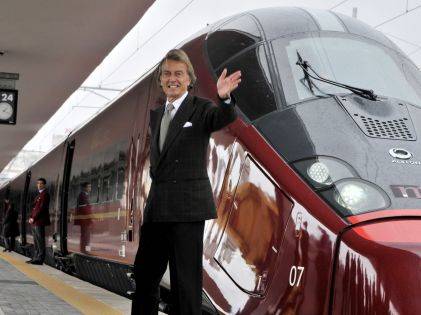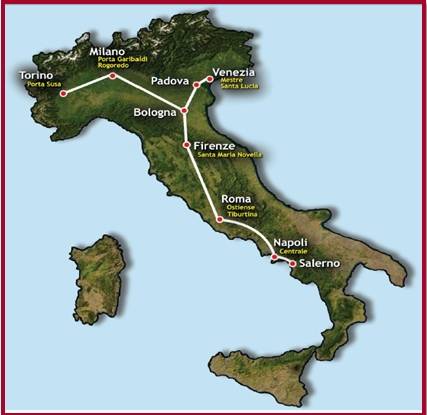Meet Italo, Italy's New High Speed Train - and the First Breach in a Long-Standing Industrial Monopoly
April 28 marked the beginning of a new era in Italy: it was the day that Italo, the high speed train of the Nuovo Trasporto Viaggiatori (NTV), had its first trip, from Naples to Milan (with stops at Roma Tiburtina, Florence and Bologna). The name was chosen together with the passengers, through a survey launched by NTV on the internet, after more than 37 thousand votes were received. Four names were selected from among all those suggested: Velox, Italo, Saetta and Mercurio. The name with the most votes was indeed Italo.
NTV was founded in December 2006 by the entrepreneurs Luca Cordero di Montezemolo,
Diego Della Valle, Gianni Punzo (with equal quotas of 33,5%) and Giuseppe Sciarrone (1,5%), who were joined in June of 2008 by Intesa Sanpaolo for Imi Investimenti (20%), Generali Financial Holdings FCP-FIS (15%), Alberto Bombassei (5%) and SNCF/VFE-P SA (20%) and in January of 2009 by Isabella Seragnoli (5%).
NTV is the first private operator on the Italian high speed rail network and the first operator in the world to use the new Alstom AGV train, the train that currently holds the high speed train record. The mission of NTV is to offer passenger services on high-speed lines, presenting innovative features, exclusive customer service and valuable traveling time. The trains were developed and built by the world leader in high-speed trains, France's Alstom, which developed the TGV, and is for the first time introducing its successor, the AGV, in passenger service with the Italo.
With its fleet of 25 trains, Italo is the direct adversary of Freccia Rossa by Trenitalia, whose CEO Mauro Moretti officially welcomed the endeavor with a statement. “This new competitor means motivation to always improve and offer what the markets asks for. We have been doing high speed for a few years now and the clients are content. This is the turning point the country was waiting for. We will respond with professionalism and competence.” NTV explains that the challenge is to “seduce travelers with modern technology, quality service and travel possibilities for all different budgets.” On board people can enjoy live television and newly released films (on longer trips, a movie car is also provided, although passengers must pay an additional fee to watch films on overhead flat screen TVs), free Wi-fi and food provided by Eataly.
Italo's first train left at 7.00 am on April 28 from Naples Central Station to arrive in Milan Porta Garibaldi. All tickets were sold. Italian media reported on the event, the passengers reactions, which were for the most part positive, but they decided to focus on the negative.
Ansa, Italy's leading news agency, reported on the complaints that followed the first trip: issues with Wi-fi connection and the inability to move from the “Smart” cars to those of a superior level. These disservices were reported by Codacons (an umbrella group of associations for the protection of the environment and of consumers and users), whose inspectors traveled on the inaugural trip. “Unfortunately we must report that Italo's first disappointment is with its Wi-fi service. It was not working and that caused a real ruckus and no passengers were able to go online,” Carlo Rienzi, president of the consumer association explained. He also added his disappointment regarding the interdiction to access higher classes.
“We tried to check out other classes in order to test comfort and services, but an employee stopped us,” Rienzi continued, “explaining that if you are in Smart you cannot access Prima and Club, two higher classes, and if we wanted a peek we could just look through the window. We see it as unfair discrimination that could have negative repercussions even on safety. If there is a fire in the Smart section, for example, how can passengers run to safety if they cannotaccess any other section of the train?”
NTV denies that passengers were not allowed to move to different areas of the train. They released a statement that said that “Because of the people's enthusiasm and curiosity, personnel on board was happy to show many of them around even though regulations and privacy issues say that people should stay in their seats.”
In regards to the Wi-fi issues, NTV admits there was a malfunction in the Rome-Bologna stretch, but it was readily fixed by on board technicians who are traveling on the trains during the first weeks just to fix possible issues.
Italian newspaper Il Fatto Quotidiano adds that there were some issues with the food as well. The site Puntarella Rossa, an independent web site that judges food in all Italian restaurants and that was invited on Libero's first trip, had nothing against the quality of the food, but had issues with the price/portion ratio. “Puntarella Rossa's guests tried the Ortolano (vegetarian) menu. Its main course was Involtini Bicolore, carrot or zucchini rolls stuffed with rice, grana padano, basil, almonds, walnuts, parsley, oil, lemon and vinegar. The menu included 50 grams of spreadable Parmesan cream to be eaten with Sardinian crackers called Bistoccu, two cookies, a small bottle of water and a Illy espresso. The cost of the menu is 20 Euro. And it is even worse for those in the lower Smart class where there are no menu choices. There also are only two vending machines selling snacks and beverages. Puntarella Rossa had no problems suggesting to all travelers to bring their own food from home.”
And this is not the last issue, as The Ente Nazionale Proporzione Animali (ENPA, National Association for the Protection of Animals) claims NTV followed the bad example ofTrenitalia, in their treatment of animals. Pets of medium-large size are not allowed on board. “We ask Montezemolo to get rid of this ridiculous discrimination,” ENPA representatives declared, “Italo welcomes only pets that are 10 kilos or smaller and there is no reason for this limitation.” They continued to explain that French, German and British high speed trains offer excellent service for pets of all sizes. “One out of two Italians owns a pet so not allowing them to travel can also have negative repercussions on the companies themselves that could have the possibility to make more money.” And let's not get into the issue of animals being abandoned during the summer months, which is a plague that has been affecting Italy for years.
There are only a few examples of positive reactions in the Italian press, although overall they say passengers were content. Ansa briefly reports on some reactions from clients. “Valerio arrived in Bologna and traveled first class. 'Finally there is an alternative. Service was good, personnel treated us really well, I hope this is not because they have just started,' he has been reported saying.”
The ride is quiet and smooth (the train has no locomotive and the motors are equally distributed throughout each car, making for a quieter ride), Italo features its own Internet portal, filled with information about museums, places of interest and shopping destinations at the train's next destination, two compartments are also offered for families who want to travel together or where business people can hold meetings, who wants some quiet time can go to the"Relax" department, where mobile phones must be shut off, the seats are comfortable and the windows are much larger than on other similar high-speed rail. Plus the varied price list makes traveling affordable to all.
Seven trains have already been produced and 25 are expected to be built by fall. They will be deployed on Italy's most important north-south train line running between Milan, Bologna, Florence, Rome and Naples. Some trains will also travel to Venice in the north and Salerno in the south. In total, the company plans to offer 50 trips a day. Starting on August, 3 pairs of trains will go from Naples to Salerno, while on December 9 Naples-Turin line will be launched.





































i-Italy
Facebook
Google+
This work may not be reproduced, in whole or in part, without prior written permission.
Questo lavoro non può essere riprodotto, in tutto o in parte, senza permesso scritto.